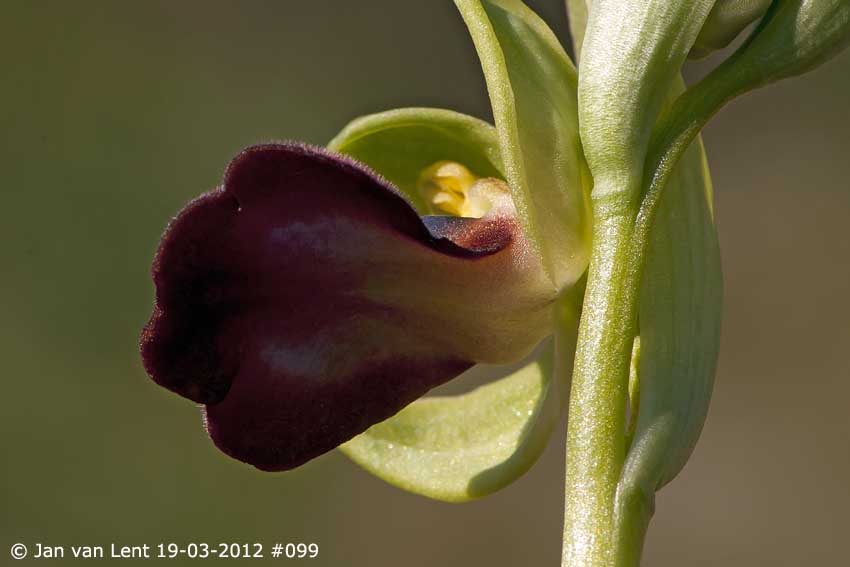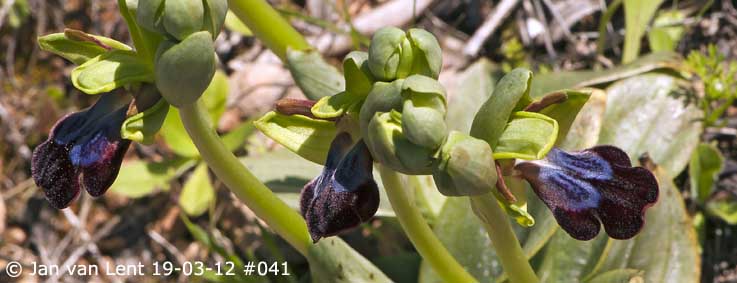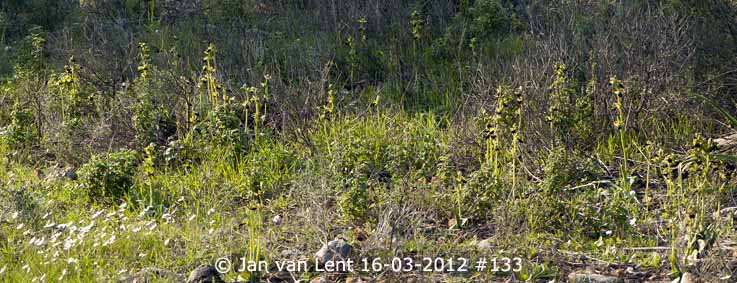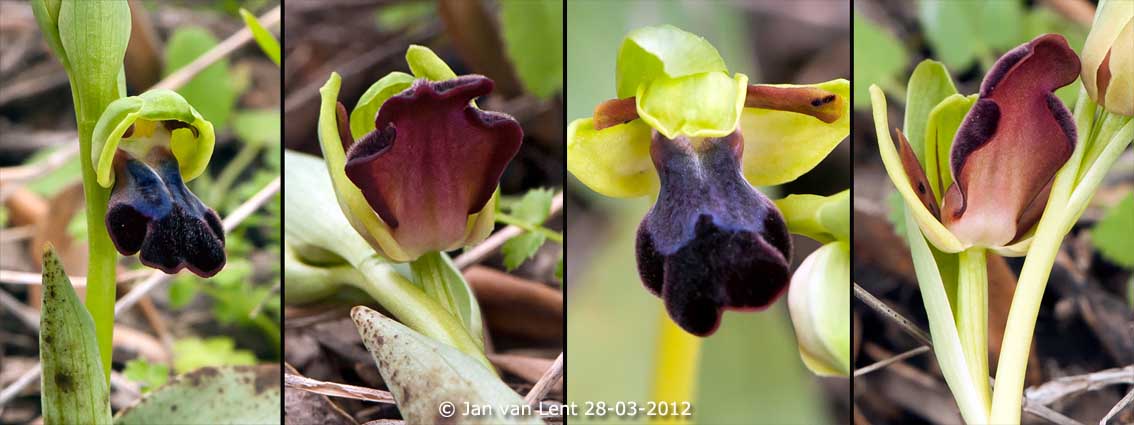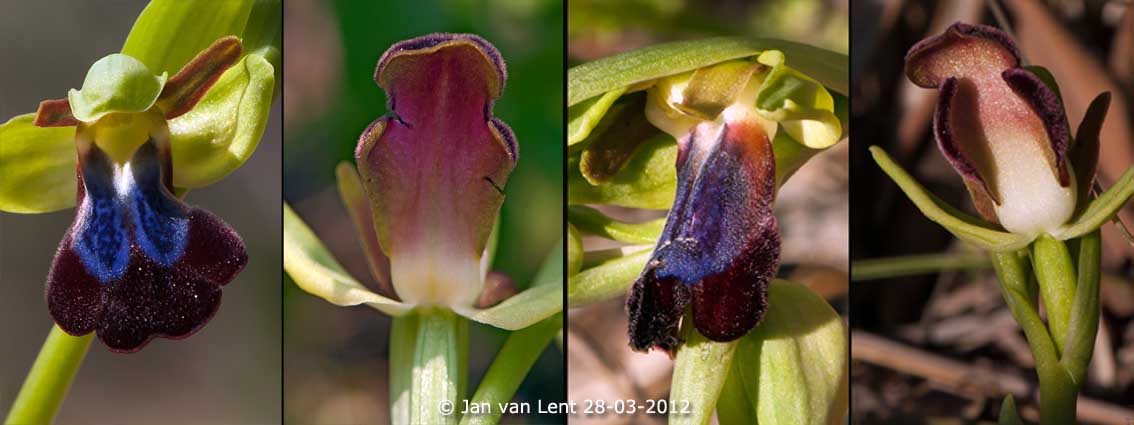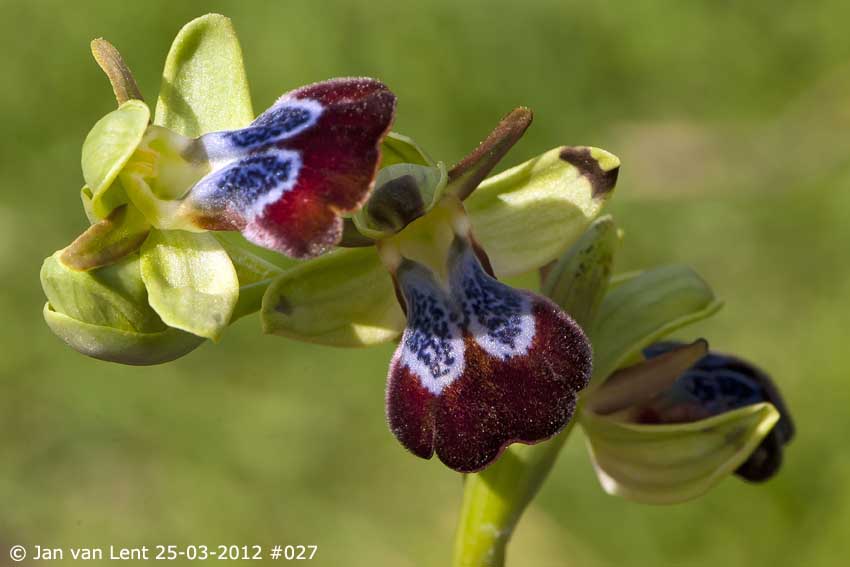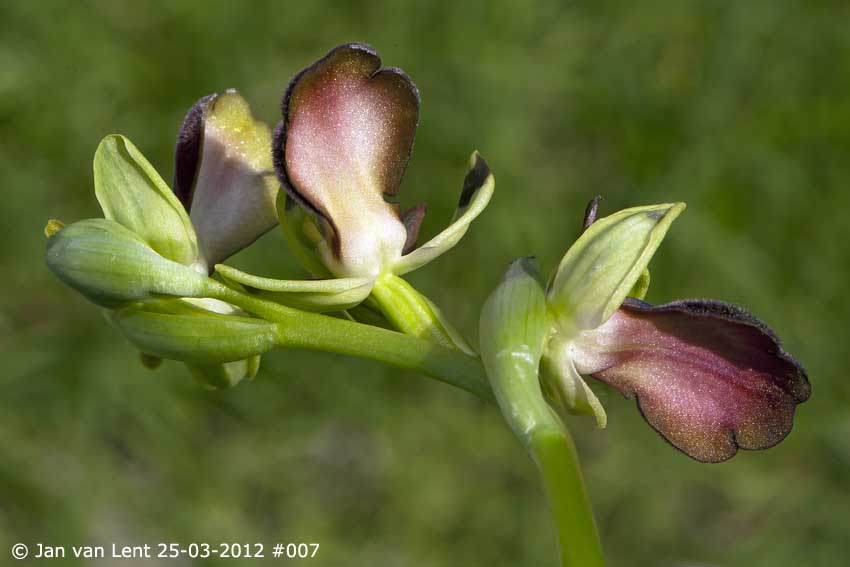Habitat: Uphill Larissos valley.
Ophrys mesaritica, Larissos corner. © JvL 19-3-2012 #099
Ophrys mesaritica H.F.Paulus, Ch. Alibertis & A. Alibertis 1990. Ophrys iricolor group, 2 species on Lesvos: Ophrys mesaritica & Ophrys iricolor.
HUNTING: It’s not always that I go out for an Orchid hunt and return with hundreds of photographs of a species which I haven’t found before. For instance like today. Five hours driving and walking without seeing one single Orchid. And after a certain time you don’t see ‘things’ clearly anymore. So time for a coffee and up to a habitat where you know for sure that ‘they’ are around. The only thing you never know is: am I at the right time? Orchids flower approximately for 3 weeks, but every year this is at a different time because of the weather of the previous months (see BLOG 1). But sometimes you are lucky and sometimes you’re not.
Ophrys mesaritica, Larissos corner. © JvL 19-3-2012 #041
HABITAT: Therefore I went to a special habitat, next to an old cement or asphalt factory and nowadays a car dump. This area gets dirtier every year; everywhere you look there is rubbish, plastic, cut off olive branches, toilet paper and things you don’t want to know what they are! But in between all this dirt there are Orchids! And nice ones too! But today I didn’t see any, only the rosettes so I have to blog about them another time. I drove a little bit further on a very small track, the branches of some trees and shrubs made nice scratches on the sides of my car, and then you can’t go further, because you’re in an olive grove. You step out of your car, you look around and the picture below is what I saw on the 28th of February two years ago.
Ophrys mesaritica, Larissos corner. © JvL 28-2-2010 #133
On first sight you think: ‘O, that’s Ophrys iricolor’. But then you think; ‘what the hell, iricolor in February, that is not possible because they start flowering somewhere at the end of March/beginning of April, so could this be Ophrys mesaritica?’ But Ophrys mesaritica is not known to grow on Lesvos, only on Crete, Kythera, Kefallonia, Lefkada and Corfu. But then what? Those Ophrys are definitively not Ophrys iricolor! Of course you read your orchid books carefully so you know that the underside of the flower of iricolor is red and from mesaritica green. Yes. So you look carefully at their bottoms and they are all… reddish! And to make a jump in time; the last two years I looked at hundreds of bottoms of Ophrys from the iricolor group. And I saw dark & light red, light & dark brown, whitish-green & reddish-green bottoms! And actually who says those plants can’t be Ophrys mesaritica? No orchidologist, florists, biologists or botanists are around in February or March to check the bottoms of those Ophrys on this habitat or on Lesvos. Therefore I did that for them, and all those poor Ophrys are suffering from heavy afterpain on their flower stems…
On Lesvos I found between the middle of February and the middle of March a lot of Ophrys which are definitely NOT Ophrys iricolor if we consider their time of flowering, the size of those plants (mesaritica grows higher), the different way of flowering (mesaritica have more vertical hanging flowers, the flowers of iricolor are more horizontal standing) and mesaritica has also more flowers then iricolor. I counted max 8 for mesaritica, max 4 for iricolor.
RESEARCH: ANTONOPOULOS (2009) made an iricolor group which includes Ophrys astypalaeica, Ophrys iricolor, and Ophrys mesaritica. But: ‘Differentiation between the species of this group do not present problems; since the species have different geographical distributions or different flowering periods (Ophrys mesaritica flowers earlier)’. Thanks Zissis! I thought I had an identification crisis or a determination problem but thanks to you I haven’t!
Ophrys mesaritica, Larissos corner. © JvL 28-2-2010 #728, #732, #740, #742
And lets see what BAUMANN/KÜNKELE/LORENZ (2006) have to say about Ophrys mesaritica. ‘Distinct from subsp. iricolor by earlier flowering time, smaller flowers and lighter (only green?) lip bottom. Lip 12-14 x 9-11mm, violet brown. (Iricolor 12.5-17 x 12.5-16mm, velvety black violet)’. Interesting that they write ‘lighter’ and only ‘green’ with a question mark so they are also not sure about the bottom colours!
Ophrys mesaritica, Larissos corner. © JvL 19-3-2012 #091, #088, #075, #080
And they still use the name Ophrys iricolor ssp. mesaritica (H.F. Paulus, C. & A. Alibertis) Kreutz. Kreutz? This is after 1990 because earlier it was Ophrys mesaritica H.F. Paulus, C.& A. Alibertis 1990. Maybe Kreutz thought that: a) mesaritica is a subspecies of iricolor, so I like to name it like that; b) this name was still available because nobody claimed it yet and so I can put my name behind it. Kreutz is ‘normally’ not an orchidologist who renames species into subspecies, more the other way around. And if we search in ‘Die Orchideen der Türkei’ (1998), in ’Die Orchideen von Rhodos, Karpathos’ (2002) and in ‘The Orchids of Cyprus’ (2004), all by the hand of C.A.J. KREUTZ, then we don’t find an Ophrys iricolor ssp. mesaritica or an Ophrys mesaritica. Only in this last book he mentions Ophrys mesaritica: ‘As KRETZSCHMAR’, who visited the island (Cyprus) in February, reports (1995), these Cypriot early-flowering plants show no variation whatsoever from the normal type, as happened, for example on Crete, where the early flowering taxon was separated and described by Paulus & Alibertis as Ophrys mesaritica.’ And: ‘A distinctive characteristic of Ophrys iricolor is the ventral side of the labellum, which is always reddish or reddish brown.’ Ventral? So my header should be: Ventral’s up?
In his iricolor group DELFORGE (2005) described 5 species: Ophrys astypalaeica (endemic to the island Astypalea in the Dodecanese), Ophrys iricolor (whole Eastern Mediterranean), Ophrys mesaritica (South-central Crete, Malta, ?Lesvos), Ophrys vallesiana (Northern Tunisia and Kroumirie?) and Ophrys eleonorae (Central Mediterranean). Ah, so maybe Delforge visited Lesvosin February/March? Let’s read what he writes in his ‘Discussion of the Ophrys iricolor group’: ‘The 2 central Mediterranean species (O. eleonorae and O. vallesiana) seem to be very closely related, linked especially by the concentric coloration of the centre of the underside of the lip – crimson bordered with yellowish-green. The structure and colour of the lip may also link the 3 eastern species into a cohesive group, of which O. iricolor would be the central figure; nevertheless, O. mesaritica is known from Crete and Malta and probably occurs on Lesbos, and this may indicate a central ancestral position for this species (O. mesaritica, JvL) within the group.’
Ophrys mesaritica, Larissos corner. © JvL 25-3-2012 #027.
BOTTOM-LINE: Let’s talk about colour. Yes, the flowers of Ophrys mesaritica are a little bit more reddish-brown from the top and the bottoms… well, as you can see on my photographs I found mesaritica with red, dark brown, crimson red, almost green and almost whitish-green undersides. But how come? Well, it may be very simple: the first flowers to appear have dark red bottoms; the older and the bigger the plant grows the bottoms just get paler and paler…
Ophrys mesaritica, Larissos corner. © JvL 25-3-2012 #007.
And because I think they’re not Ophrys iricolor and if you think that they’re not Ophrys mesaritica then there are only two other options: either they belong to the central Mediterranean species like O. eleonorae and O. vallesiana or it’s a new and (of course) endemic species, Ophrys larisotica! Etymology: From the Larisos valley of Lesvos.
Jan van Lent, Lesvos, 27-03-2012.
Nickelback: ‘Bottoms Up’ (cover by X-Y)
https://www.youtube.com/watch?v=UgPDgkEzpeg

